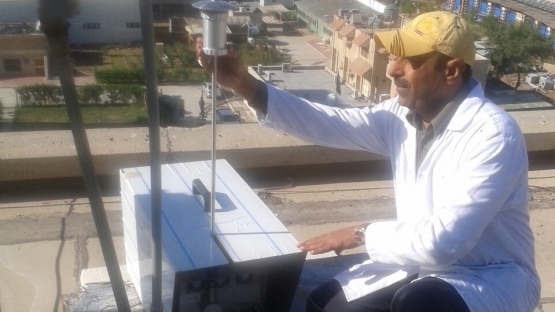The American University of Sharjah (AUS) is actively participating in the activities of the IAEA Technical Cooperation Project RAS0072 “Evaluating and Mapping Air Pollutants Using Nuclear Analytical Techniques in ARASIA State Parties”. The project investigates properties of natural pollutants such as sea salts and dust storms in order to understand the reaction/interaction of natural pollutants with anthropogenic emission that form secondary pollutants with fine and ultrafine particulate sizes and modified toxicity.
Within the activities of this project, the IAEA Technical Cooperation Department in collaboration with the AUS organized a "Regional Coordination-Review Meeting and Workshop on Evaluating and Mapping Air Pollutants Using Nuclear Analytical Techniques" in the period April 19-24, 2015.
The meeting discussed the progress of the RAS0072 project for the year 2014 until March 2015 and reviewed the project's plan for the rest of 2015. During the meeting the new TC project designs for the TC cycle 2016-2017 with the title: "Investigation of atmospheric particulate matter and pollution source contributions in urban environments of ARASIA region using nuclear analytical techniques" was formulated.
One full day was dedicated for hands on workshop at the UAE National X-ray Fluorescence Laboratory (NXFL), at the University of Sharjah (UoS), during which participants measured samples collected at the same time by different member states. The NXFL is part of the UoS's XMCA (described below) that was setup by initial funding from the IAEA. The samples were analyzed using complementary techniques: XRF, SEM/EDS and XRD. A good agreement was achieved with the measurement results obtained by Proton Induced X-ray Emission (PIXE) performed in Florence, Italy. A quick comparison between the constituents of air pollutants collected in Amman, Bagdad, Beirut and Sharjah was performed.
Analysis of the collected samples was performed at the X-ray Materials Characterization and Analysis Laboratory (XMCA) at the University of Sharjah. The state of the art facility grew from an X-ray fluorescence laboratory established in collaboration between AUS and UoS and supported by the IAEA to study cultural heritage and environmental research into a fully equipped laboratory with techniques including XRF, XRD, FTIR, RAMAN, SEM/EDS and a few more complementary techniques. Among other important results that were observed in the ongoing study, is the presence of ammonium sulfate. Ammonium sulfate forms as a secondary pollutant resulting from the reaction of sulfur dioxide (SO2) with Oxygen, water vapor and ammonia (NH3). Sulfur dioxide and nitrogen oxides (NOx) originate mainly form fossil fuel burning in energy production processes such as electric energy generation and petroleum refining. It is also generated in commercial and residential use, combustion for industry, extraction and distribution of fossil fuels and by various transportations (cars, and air traffic).
The UAE has taken practical and important steps towards reducing the use of fossil fuel by opting for nuclear energy generation, several projects on solar energy both in Abu Dhabi and Dubai, and enacting regulations and community based initiatives such as the ambitious projects of waste to energy in Sharjah and the green building act and the metro project in Dubai. These projects will have definitive and obvious impact on air quality and therefore the quality of life in the UAE.


